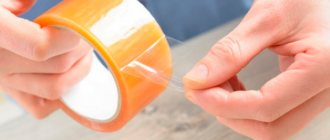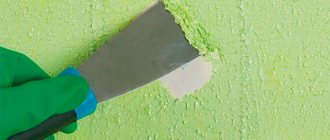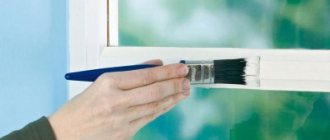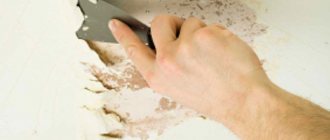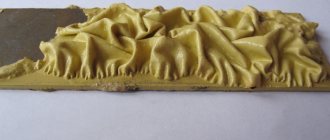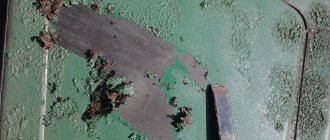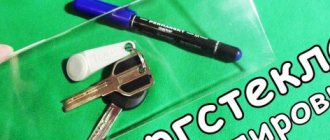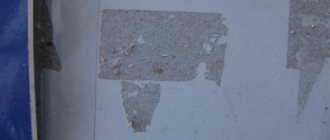You can polish plexiglass with toothpaste
Due to its properties, plastic is used in all areas of human life, therefore, during long-term use, all products are subject to various mechanical influences. Unfortunately, over time, cracks and scratches appear on the plexiglass, and it loses its shine. But it turns out that with the help of simple manipulations you can restore a beautiful appearance to this material.
The main disadvantage of plexiglass is the low hardness of the surface, which is why there is a high probability of scratches. Today, new research is being conducted, new components are being added in the hope of obtaining a more durable composition. But while it is not possible to increase the strength of the artificial glass material, you need to learn how to restore its damaged appearance. And we will be able to do this only when we learn how to remove scratches from plexiglass.
How to remove old film from stainless steel?
Regular hot water or an aggressive detergent can remove such a film from stainless steel handrails and railings. By the way, if it’s high-quality stainless steel, then nothing will happen to the railings!
Interesting materials:
When will the Russia vs. Finland hockey match take place? When was the school subject Fundamentals of the Spiritual and Moral Culture of the Peoples of Russia introduced? When were the first cross-country skiing competitions held in Russia? When was universal primary education introduced in Russia? When is cosmetologist day in Russia? When is Women's Day in Russia? When did the French army invade Russia? When will Georgia open its borders with Russia? When and where in Russia was the monument to the Unknown Soldier first erected? When and why did Russia lose access to the Baltic Sea?
What do you need to know before cleaning plexiglass?
Acrylic glass is a popular material that is used in a wide variety of areas, from aviation cockpits to greenhouses.
Taking this into account, it is easy to conclude that polycarbonate is often subject to contamination of a completely different nature. Let us remind you that, despite the strength of the structure, the surface of organic glass is highly susceptible to scratches. Below we will talk about how to clean plexiglass in some everyday situations. Before you start working with polymer plastic, you should not forget that there are substances that act as solvents in relation to the material:
- ethylene chloride;
- tetrachloroethane;
- chloroform;
- benzene;
- acetone;
- ethyl acetate.
They cannot be used when working with plexiglass, otherwise negative consequences cannot be avoided.
You also need to use only products made from natural fabrics, but not wool; cotton is best. Synthetic material in contact with acrylic glass helps reduce its light transmission qualities.
When cleaning polycarbonate, it is recommended to use only non-abrasive detergents, ideally using dishwashing detergent.
Polish for plexiglass. How to polish plexiglass using a regular hair dryer
In fact, plexiglass is a popular material in production and at home. It has a lot of positive characteristics. These include transparency, thermoplasticity and strength. But with prolonged use, it may become necessary to polish it. This process can be carried out at home, spending a minimum of time and effort.
Distinctive features of plexiglass
Among the key features of the material are softness and lightness. They are achieved due to the fact that plexiglass is made from acrylic paste using chemical reactions. Externally, it is practically no different from ordinary glass.
Important! The material also has the following names: carbon glass, acrylic paste or plexiglass.
Organic glass can be easily transformed, can be processed and has high throughput rates. But it is worth considering that some chemicals can lead to the decomposition of the material.
When is polishing needed?
The need for polishing may arise in two cases: after long use or processing. Cutting often leaves tools with rough edges, chips and small cracks. In order not to harm the appearance of the panel, you need to perform polishing work. Then you will be able to avoid the problem of tarnishing and distortion of the glass surface.
Advice! You can stick a colored film on the product. This will add aesthetic appearance and strength to it.
Instructions for self-polishing
A mandatory component for polishing synthetic glass is paste. Moreover, this is not necessarily a polishing agent. Dental or chalk will do just fine. You will also need a towel or soft cloth and a hairdryer. Next you need to take the following steps:
- Selecting a polishing product;
- Applying the composition to a towel or fabric;
- Rub the product into the coating using circular movements until the desired plexiglass state is formed;
- Blow drying;
- Wash off the composition with water;
- Re-drying.
Tips and tricks
Even when performing polishing procedures yourself, it is important to take precautions and safety measures. The following points require special attention:
- Spray agents should only be applied while protecting the respiratory tract using a respirator or medical mask;
- The room where work will be carried out must be constantly ventilated to avoid high concentrations of harmful components in the air;
- When using an electric tool, you must first check its serviceability;
- When operating with a grinding machine and sandpaper, you need to wear goggles over your eyes to prevent small fragments and dust from getting into your eyes;
- It is necessary to work with gloves made of durable materials, as harmful substances can get on the skin of your hands.
By following these simple rules, you will be able to quickly and efficiently polish plexiglass, restoring its transparency, shine and attractive appearance. You will need available tools and some free time to repair products.
What methods of polishing plexiglass do you know? Share with us!
How to make plastic shine?
folk-craft method: you blow a hairdryer onto the plastic, the top layer melts and begins to shine, like in sports. Very good thing. Very good thing.
Interesting materials:
How to remove Samsung free? How to remove Samsung Pay from below? How to remove Samsung Pay from the screen? How to remove SATA drives from the Safely Remove Hardware menu? How to remove service on Skoda Octavia? How to remove the gap between linoleum? How to remove wool when washing? How to remove dog hair from a sofa? How to remove dog hair? How to remove spikes from rubber?
Removing paint and tape stains
If paint gets on the plexiglass, you should not hesitate. Apply a little sunflower oil to a cloth and wipe the problem area in a circular motion; if the paint has not yet dried, this method will be effective.
Scotch tape that has been stuck to an acrylic sheet for a long time may not come off at all. Then, first dry the strips with a hairdryer, then you will be able to peel them off. To get rid of traces of adhesive tape, follow the following algorithm:
- Dampen a rag with warm soapy water and place it on the stain.
- After a few minutes, remove the tape with a dry cloth.
- If there is no effect, moisten the cloth with gasoline or kerosene and, without significant effort, wipe the desired area in a circular motion until the traces disappear.
- The final step is to clean the surface with detergent.
The gasoline and kerosene method is also great for getting rid of old paint stains.
After handling plexiglass, it may need to be polished. You can use standard polish pastes for it. They should be applied in a thin layer to a dry and clean surface, then rubbed in with a piece of natural material or a special polishing unit until a shine appears.
Characteristics and properties of plexiglass
Containers and stands, advertising signs and boxes, shelves and partitions, and glasses are made from plexiglass. It is used in the manufacture of doors and shelving, furniture elements, aquariums and so on. The material is available in different colors. But the most popular are transparent and milky plexiglass.
Compared to ordinary glass and organic glass, there are no serious differences. At the same time, it is lighter, more comfortable to use and more practical. The material can be cut and drilled, sanded, painted, engraved and shaped into any shape.
But over time, with improper care and due to mechanical stress, the material may become cloudy or yellow. Scratches may occur on the surface. Such defects spoil the appearance of the products, distort the surface and greatly reduce the light transmittance of the glass.
How can you remove film from glass?
How to remove tint film from car glass? The simplest way, which does not require financial costs, but only endurance and perseverance, is to remove the coating with a sharp knife. Having picked up the edge of the film with the tip of the blade, slowly pull it towards you and down - this will reduce the amount of glue remaining on the surface.
Interesting materials:
What kind of bird is a dove? What bird makes a rattling sound? Which bird is considered the symbol of Halloween? Which race is better for a magician in WWII? What's the difference between 4WD & AWD? What is the difference between acrylic and polyester? What is the difference between Frappe and Frappuccino? What is the difference between a Dove and a Turtle Dove? What is the difference between Langoustines and shrimp? What is the difference between SIM and USIM?
Fighting scratches on plexiglass
Even deep scratches on polycarbonate can be repaired. This will help:
- Two types of sandpaper: 800 and 1500 grit.
- Polish, GOI paste is excellent.
- Natural polishing material.
We clean a sheet of polymer plastic that has been previously washed with a mild detergent and moistened with water using 800-grit sandpaper; this will help get rid of large scratches.
Then we sand it using 1500 paper. Now the sheet is prepared for polishing. Scratches may be minor and you may need to resort to sandpaper, in which case there is no need, polishing alone will be enough. We hope we were able to answer the question: “How to clean plexiglass?”
How to clean plexiglass from glue
Quite often, glue gets on plexiglass products, or this happens when there is a desire to make something yourself or repair products made from this durable material. Depending on what kind of glue you used, your further actions will depend.
Regular PVA glue can be easily cleaned with a damp cloth. Stronger glue will be more difficult to handle. You should clean the surface of the material with fine sandpaper; this may require some effort on your part. After the surface is cleaned, it is necessary to polish it; use GOA paste and a soft cloth for this purpose.
Remember, to clean the surface of plexiglass products, you may need not only a lot of time, but also effort, so be careful with materials such as glue, foam, tape and others.
How to remove cloudy glass?
Take a solution of white vinegar and distilled water, mix in equal proportions. This remedy is especially suitable in the presence of turbidity
and tarnish.
the glass
to soak in the solution for at least 12 hours. Then set it to dry.
Interesting materials:
Where can I register at my place of residence? Where can I apply for a social scholarship? Where can I apply for a social scholarship for a student? Where can I apply for the status of a large family? Where can I get a registration certificate for an apartment? Where can I register ownership of a plot of land? Where can I register ownership of a plot of land? Where to register land ownership? How to issue a deed of gift? How and where to draw up a deed of gift for an apartment?
Film removal methods
So, dried protective film can be removed from the surface in the following ways:
Methods for removing protective film
Next, we will consider in detail how to clean plastic windows from film using each of these methods.
In the photo - removing the protective coating using a scraper
Method 1: using a scraper
First of all, try to remove the film using a scraper or other sharp object, for example, a mounting knife or even a blade. The only thing is that you need to work with sharp tools very carefully so as not to damage the plastic .
Instructions for removing the coating using a scraper are as follows:
- First of all, you need to pry off the edge of the protective coating using a scraper or other sharp object. The peeled edge must be large enough to be grasped;
- next you need to pull the foam and try to tear it off in one quick movement;
- If the tape begins to tear, pry it again, but try to use the cutting tool as little as possible and work more with your fingers so as not to scratch the plastic.
A similar method can be used if the protective coating has not yet been destroyed by exposure to the sun . Otherwise, it will not be possible to tear off the film, and it is not advisable to constantly pick at it with a scraper, since it will take a lot of time and will certainly lead to scratches on the surface of the plastic.
Even if you successfully rip off the protective coating in this way, there will likely remain areas of glue on the surface of the plastic. You can remove them in ways that I will discuss below.
An eraser will help get rid of film and glue residues.
Method 2: eraser
If the old coating becomes easy to tear or even crumble, it can be removed with an eraser. True, this method is only suitable for small areas, for example, if there is film or glue residue left in some places after using a scraper .
To clean the surface, choose a rubber band that is as elastic as possible. Simply rub the stained area with your hands, as if you were erasing a pencil from paper. As a result, the remaining glue and protective coating will roll into a roller that can be removed with your fingers.
It is very difficult to completely clean the frames in this way, so it is better to use a less labor-intensive method.
After heating with a hairdryer, the film can be easily removed
Method 3: hairdryer
If you cannot remove the coating with just a scraper, you can warm it up with a hair dryer before peeling off the film. This is done as follows:
- turn on the hairdryer at maximum power and thoroughly heat a small area of the coating;
- then pick up the tape and pull its edge. After heating, the glue should become much more “pliable”;
- after this you need to heat the next area and remove it in the same way;
- the remaining glue must be reheated and then wiped off with a paper towel.
An even more effective way to tear off the protective coating is to heat it with a steam generator. You can also use a hair dryer, however, work with it carefully so as not to melt the film and especially the plastic frames.
I must say that this method is quite effective. As a rule, it allows you to get rid of even the most ingrained glue into the surface of the plastic.
Denatured alcohol can be purchased at a household chemical store.
Method 4: medical or industrial alcohol
Now let's look at how to remove film from plastic windows using alcohol. This method is effective in removing film and adhesive residues.
The procedure is carried out as follows:
- the contaminated area should be treated with medical 96 percent alcohol or denatured alcohol using a spray or cotton solution. As the alcohol dries, it should be reapplied within a few minutes;
- Then you can start removing the old adhesive and film residue using a paper towel. As you work, you may need a scraper or other tool to pry off the film.
It must be said that alcohol allows you not only to clean the surface of the old protective coating, but also to bleach the plastic, as well as get rid of other contaminants.
Essential oil will dissolve the adhesive
Method 5: vegetable oil
When choosing what to wipe off the remaining coating and glue, you can give preference to vegetable oil. The latter can be anything, the only thing is to keep in mind that the oil will leave a smell on the surface of the window, even after you wash it . Therefore, it is best to use an essential oil that smells pleasant.
Instructions for removing the coating with this product look like this:
- Before washing the surface, you need to apply oil to the contaminated areas using a cotton swab, and then wait an hour. As the oil dries, the surface should be periodically lubricated;
- after the specified time, the contaminated areas should be wiped with a paper towel;
- At the end of the work, you need to wash off the oil with a non-abrasive detergent.
White spirit solvent
Method 6: white spirit
White spirit is a fairly potent agent. The only thing is, before using it, wipe a small, inconspicuous area of plastic with solvent . The fact is that not all PVC windows are resistant to this solvent.
If you are sure that the solvent will not harm the plastic, perform the work in the following order:
- the edge of the film must be torn off using a scraper or other sharp object, as far as possible;
- then the space between the film and the surface of the plastic should be treated with a solvent;
- You should wait a few minutes before peeling off the film. After this, the tape should come off easily;
- in the area where the film has not begun to tear, white spirit should be applied again.
If vapor barrier tape was used when installing the window, make sure that no solvent gets on it, as it may become damaged.
Detergent Shumanit
Method 7: “Shumanite”
"Shumanite" is a powerful detergent, which is intended primarily to remove grease from the surface . However, it also copes well with adhesives that are used when gluing protective coatings. The only thing to remember is that Schumanite contains substances that can react with frames, so you should not apply it for a long time.
Dried film and old glue are removed using this product as follows:
- old glue should be treated with the compound. If there is old coating left on the surface, the area underneath it should be treated, as well as the edges along the tape;
- almost immediately after applying Schumanite, the coating should be peeled off and the remaining glue should be wiped off with a damp towel;
- At the end of the work, the surface of the plastic must be washed with any suitable detergent.
HG Sticker Remover
Method 8: "HG Sticker Remover"
When talking about how easy it is to remove old film, one cannot fail to mention such a product as HG Sticker Remover. It is sold in household chemical stores, usually in 300 ml bottles.
In general, this composition is intended for removing stickers and all kinds of self-adhesive stickers from the surface. However, as practice shows, with the help of Sticker Remover, old protective film can be easily removed.
The principle of its use is similar to working with other solvents:
- before tearing off the film, you should pick it up and treat it with a product;
- after a few minutes the coating can be peeled off;
- then the surface should be treated again with the composition;
- after a few seconds, the product with glue residue must be removed using a paper towel or a clean rag.
Cosmofen 10
Method 9: "Cosmofen 10"
If you ask manufacturers of plastic windows to advise you on a means for removing the protective coating, they will probably tell you about “Cosmofen 10”, which is a weak PVC solvent designed specifically for such purposes.
You can also use its analogue, which is called “FENOSOL”. The price of these compositions ranges from 300 rubles per liter.
As in previous cases, the old film is first picked out, after which the composition is applied. These products can also be used to remove glue residue.
Before you wash the surface of the glue, you need to wait a few minutes for the product to react.
Solvent P-12
Method 10: “P-12”
Finally, I’ll tell you about the “RP-6” product, which is an acrylic solvent. With its help, you can easily remove glue residues.
The only thing is, before doing the work, be sure to check whether the solvent does not react with the plastic frames. The fact is that some types of plastic can change color under the influence of RP-6.
The composition is used in the same way as other solvents. Typically, a few minutes is enough for it to react with the old glue.
This is, in fact, all the information about how to remove film from plastic windows that I wanted to share with you.
